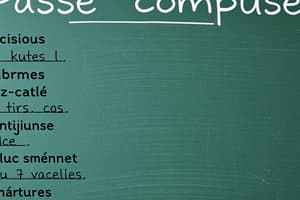Podcast
Questions and Answers
Which of the following verbs uses "être" as its auxiliary in the passé composé?
Which of the following verbs uses "être" as its auxiliary in the passé composé?
- Dormir (to sleep)
- Venir (to come) (correct)
- Manger (to eat)
- Parler (to speak)
What is the past participle of the verb "faire" (to do/make) in the passé composé?
What is the past participle of the verb "faire" (to do/make) in the passé composé?
- Faits
- Fais
- Fait (correct)
- Faite
How is the negative form of the passé composé formed?
How is the negative form of the passé composé formed?
- By placing "ne" before the main verb and "pas" after the auxiliary verb.
- By placing "ne" before the main verb and "pas" after the main verb.
- By placing "ne" after the auxiliary verb and "pas" before the main verb.
- By placing "ne" before the auxiliary verb and "pas" after the main verb. (correct)
What is the correct form of the passé composé of the verb "aller" (to go) in the sentence "Elle ______ à l'école hier."(She went to school yesterday).
What is the correct form of the passé composé of the verb "aller" (to go) in the sentence "Elle ______ à l'école hier."(She went to school yesterday).
In which of the following sentences does the past participle agree with the subject in the passé composé?
In which of the following sentences does the past participle agree with the subject in the passé composé?
Which of the following is NOT a characteristic of the passé composé?
Which of the following is NOT a characteristic of the passé composé?
How is a question formed in the passé composé?
How is a question formed in the passé composé?
What is the correct form of the passé composé of the verb "prendre" (to take) in the sentence "Je ______ un café ce matin."(I took a coffee this morning)?
What is the correct form of the passé composé of the verb "prendre" (to take) in the sentence "Je ______ un café ce matin."(I took a coffee this morning)?
Flashcards
Passé Composé
Passé Composé
A French past tense formed using auxiliary verbs and past participles.
Auxiliary Verbs
Auxiliary Verbs
Verbs used to form the passé composé: 'avoir' or 'être'.
Regular Verbs
Regular Verbs
These mostly use 'avoir' as the auxiliary in passé composé.
Irregular Verbs
Irregular Verbs
Signup and view all the flashcards
Past Participle Agreement
Past Participle Agreement
Signup and view all the flashcards
Negative Form
Negative Form
Signup and view all the flashcards
forming Questions
forming Questions
Signup and view all the flashcards
Common Mistakes
Common Mistakes
Signup and view all the flashcards
Study Notes
Formation of the passé composé
- The passé composé is formed using the auxiliary verb "avoir" or "être" plus the past participle of the main verb.
- The choice between "avoir" and "être" depends on the type of verb.
- Regular verbs use "avoir" as their auxiliary.
- Irregular verbs use either "avoir" or "être".
- To form the passé composé, the past participle agrees in gender and number with the subject of the sentence, if it's a feminine or plural noun.
Verbs using "avoir"
- For most verbs, the auxiliary is "avoir."
- The past participle follows standard rules for conjugation. There is no specific agreement of the past participle.
- Example: J'ai mangé (I ate) - Nous avons mangé (We ate) - in these cases, the word mangé does not change in form.
Verbs using "être"
- These verbs describe actions that involve a change or movement of the subject.
- The past participle will change for gender and number with the subject.
- Examples of verbs that use "être" as the auxiliary:
- aller (to go)
- naître (to be born)
- mourir (to die)
- rester (to stay)
- venir (to come)
- arriver (to arrive)
- partir (to leave)
- descendre (to go down)
- monter (to go up)
- entrer (to enter)
- sortir (to exit)
- tomber (to fall)
Irregular past participles
- Many verbs have irregular past participles.
- Students need to memorize these forms.
- Examples of irregular past participles:
- aller: allé / allée
- faire: fait
- dire: dit
- apprendre: appris
- ouvrir: ouvert
Negative form
- The negative form of the passé composé is created by adding "ne" before the auxiliary verb and "pas" after it.
- Example: Je n'ai pas mangé (I did not eat).
Questions
- Questions in the passé composé are formed using inversion: the auxiliary verb comes before the subject.
- Example: Avez-vous mangé? (Did you eat?), Es-tu allé? (Have you gone?) - this uses an inversion.
Usage of the passé composé
- The passé composé describes an action that is completed in the past.
- It often corresponds to English uses of "have/has done."
- It's used to express actions that are finished, and are not necessarily tied to a specific time in the past, unless specified in the context.
Common Mistakes
- Incorrect choice of auxiliary verb ("avoir" or "être").
- Incorrect agreement of past participles (for verbs using "être").
- Confusion with other past tenses, like the imparfait. The imparfait is used for actions that occurred habitually or continuously in the past. The passé composé describes a completed action.
- Misspelling of irregular past participles.
Practice
- Regular practice with various verbs in the passé composé, including both regular and irregular verbs.
- Using a verb conjugator.
- Completing exercises.
- Checking answers for accuracy in usage and grammar.
Studying That Suits You
Use AI to generate personalized quizzes and flashcards to suit your learning preferences.




